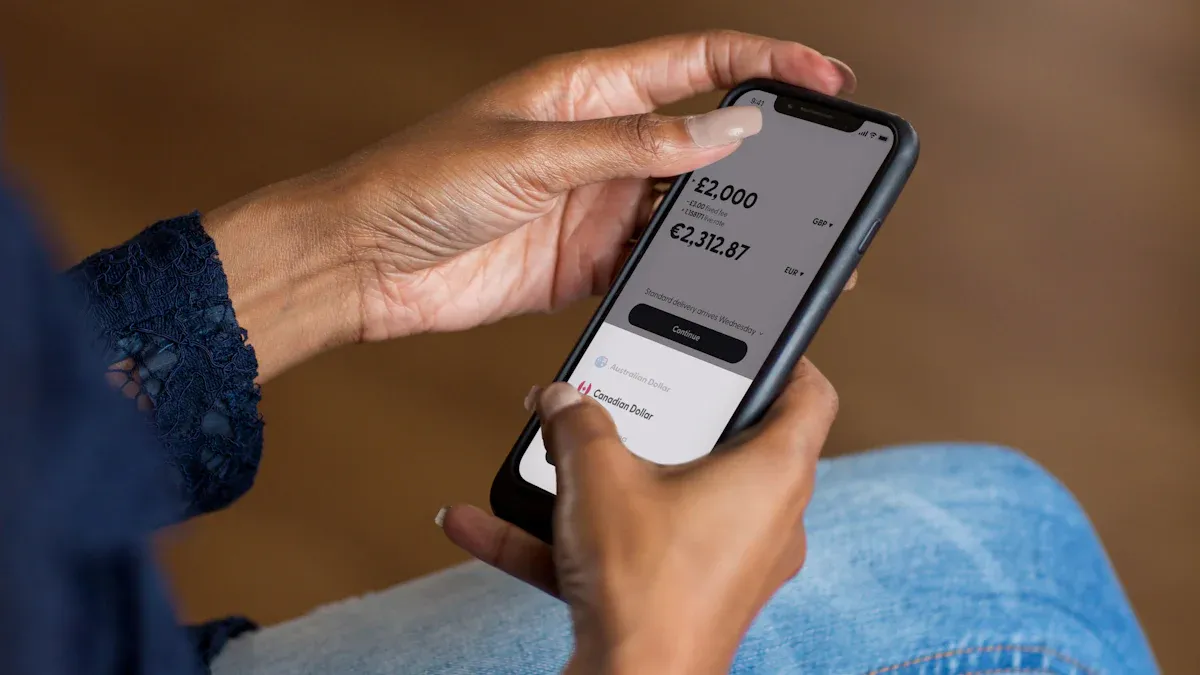- EasyCard
- Trade
- Help
- Announcement
- Academy
- SWIFT Code
- Iban Number
- Referral
- Customer Service
- Blog
- Creator
Zelle Transfer Limits: How to Manage Your Zelle Transfer Amounts?

Image Source: pexels
You need to understand a core fact: Zelle transfer limits are determined by your bank, not the Zelle platform itself. In most cases, you cannot proactively request to increase this limit. Zelle’s user base exceeds 150 million, and its transaction volume reached $806 billion in 2023, making it a widely popular transfer tool.
💡 Key Tip
Understanding and planning your fund usage is the key to effectively managing your Zelle limits.
Key Takeaways
- Zelle transfer limits are determined by your bank, not the Zelle platform. You usually cannot proactively increase the limit.
- You can check your transfer limit in your bank’s app or Zelle’s standalone app. Limits vary across banks.
- Personal account conditions affect Zelle limits, such as account type, duration of account ownership, and transaction history.
- When the transfer amount exceeds the limit, you can split the payment into batches or use other payment tools like wire transfers or PayPal.
- In special cases, you can contact your bank to inquire about temporarily increasing your Zelle limit.
Checking Your Zelle Transfer Limit

Image Source: unsplash
Knowing your specific limit is the first step to effectively managing your funds. Since limits are set by your bank, the inquiry path is usually through your bank’s app or online banking. Below, we outline two main inquiry channels.
Partner Bank Channels
If your bank is a Zelle partner, you can find limit information in its official app or website. However, the way this information is displayed varies across banks.
-
Directly Displayed Limits: Some banks clearly list your transfer limits. For example, you can find information through the following steps at Bank of America:
- Log in to your online banking account.
- Navigate to the “Transfer | Zelle®” section.
- This page typically displays your daily and monthly limits directly.
-
Dynamically Displayed Limits: Other banks, such as Chase, do not show limits in a fixed location.
You can only see the available limit for the current transaction and your remaining daily limit when initiating a transfer. This limit dynamically changes based on factors like the recipient or account history.
Additionally, you need to note that limits are not only about the amount. Many banks also restrict the number of transfers. For example, most Wells Fargo personal accounts have a daily limit of $3,500 and a monthly limit of $20,000, calculated on a rolling 24-hour and 30-day cycle.
Zelle Standalone App Channel
If your bank or credit union is not partnered with Zelle, you need to download and register for Zelle’s standalone app. In this case, your Zelle transfer limit is uniformly set by the Zelle platform, independent of your bank.
Typically, transfer limits through the Zelle standalone app are relatively low. The current standards are:
- Weekly Sending Limit: $500
- Weekly Receiving Limit: $5,000
This limit is fixed and can be easily found in the app’s transfer interface or settings.
Factors Determining Zelle Limits
You may wonder why your Zelle limit differs from your friend’s. The answer is simple: each person’s Zelle transfer limit is highly personalized. It is determined by multiple factors, primarily including your bank, your account conditions, and how you use Zelle. Below, we break down these factors in detail.
Bank Policies and Risk Control
Banks are the primary decision-makers in setting Zelle limits. They use limits as a key risk control tool to protect both you and the bank from fraud losses. Therefore, policies vary significantly across banks.
Most banks set daily limits between $500 and $3,500, with monthly limits up to $20,000. However, this is only a reference range, and your specific limit depends entirely on your bank.
For example, large national banks and small credit unions have noticeable differences in limits. Large banks typically offer higher limits, while regional institutions may be more conservative.
| Bank | Zelle Daily Transfer Limit |
|---|---|
| Bank of America | $3,500 |
| Chase | $500 - $10,000 (dynamically determined) |
| Wells Fargo | $3,500 |
| Citibank | $2,500 (for accounts held over 30 days) |
| USAA Federal Savings Bank | $1,000 |
| Discover Bank | $600 |
In contrast, institutions like Visions Federal Credit Union have a daily transfer limit of only $500, mainly to prioritize user fund security.
Personal Account Conditions
Beyond the bank’s general policies, your personal account conditions directly affect your limit. Banks assess risk based on your relationship with them and dynamically adjust limits.
- Account Type: Is your account a personal checking account or a business account? Typically, business accounts have much higher limits than personal accounts. For example, at Citibank, business accounts have a daily limit twice that of personal accounts, with monthly limits increasing from $15,000 to $40,000.
- Account Tenure: Are you a new or long-term customer? Banks are typically more cautious with new customers. For instance, Bank of America adjusts daily limits based on the duration of your Zelle registration. New users may have a limit of $500, which can gradually increase to $3,500 after 60 days.
- Transaction History: Your account’s daily activities, balance levels, and past transfer records are used by the bank to assess your credit and risk, influencing your limit.
Zelle App’s Uniform Standard
If your bank is not part of Zelle’s partner network, you need to use Zelle’s standalone app. In this case, your limit is independent of your bank and is uniformly set by the Zelle platform. This standard is typically lower, currently at:
- Weekly Sending Limit: $500
- Weekly Receiving Limit: $5,000
This limit is fixed and applies to all users registered through the Zelle standalone app.
Practical Strategies for Managing Zelle Limits

Image Source: pexels
Although you usually cannot directly increase the Zelle transfer limit set by your bank, this doesn’t mean you’re helpless when facing large fund needs. The key lies in “planning” and “flexibility.” Through the following practical strategies, you can effectively manage your transfer needs and bypass limit restrictions.
Planning Large Transfers
If the amount you need to pay exceeds the daily limit, the simplest and most direct method is to “break it into smaller parts and transfer in batches.”
For example, if you need to pay a $3,000 deposit to your landlord but your daily limit is $1,000, you can communicate with your landlord in advance and transfer $1,000 daily for three consecutive days.
💡 Advance Planning is Key
Be sure to communicate your transfer plan with the recipient in advance to ensure they understand and agree to this batch payment method, avoiding unnecessary misunderstandings.
Additionally, some banks allow you to schedule future Zelle payments through their online banking or app. Although the Zelle platform itself does not support preset or recurring payments, you can use this feature provided by your bank to manage your funds. The steps are typically as follows:
- Check Bank Features: Confirm whether your bank’s app or online banking supports preset Zelle payments.
- Log in and Navigate: Log in to your bank account and find the transfer or Zelle section.
- Set Transfer Details: Enter the recipient’s information and the amount for a single transfer.
- Select Future Date: Choose the specific date you want the transfer to occur.
- Confirm and Save: Review all details and save your preset transfer.
This way, you can prearrange consecutive transfers for the coming days, ensuring you don’t forget and making fund management more organized.
Combining Other Payment Tools
When Zelle’s limit cannot meet your urgent or large-scale needs, combining other payment tools is the most efficient strategy. Different tools have different features suited for various scenarios.
The table below clearly compares Zelle with other common payment methods:
| Payment Method | Key Features | Transfer Speed | Fees | Use Cases |
|---|---|---|---|---|
| Zelle | Instant, free, direct deposit | Within minutes | Free | Daily small payments, splitting bills with friends |
| ACH Transfer | Very low cost, longer processing time | 1-3 business days | Usually free or under $1 | Bill payments, payroll |
| Wire Transfer | Fast, high limit, secure | Usually same-day | $25 - $35 (outgoing) | Home down payments, large transactions |
| PayPal / Venmo | Higher limits, fees for instant transfers | Instant (with fees) or 1-3 days (free) | 1.75% for instant transfers | Online shopping, small international payments |
| Cashier’s Check | No amount limit, extremely secure | Depends on mailing and deposit time | $10 - $15 | Car purchases, large deposits |
1. Wire Transfer
When you need to quickly transfer a large amount far exceeding Zelle’s limit (e.g., for a home down payment), a wire transfer is the best choice. It offers a very high limit and typically arrives within 24 hours. Of course, convenience and security come with corresponding fees.
2. PayPal or Venmo
These platforms offer higher transfer limits than most banks’ personal Zelle accounts. If you need to make a medium-sized transfer (e.g., a few thousand dollars), they are good supplementary tools. However, note that their instant transfer feature incurs a percentage-based fee.
3. Cashier’s Check
For large and highly secure transactions, such as purchasing a car outright, a cashier’s check is unmatched. Since it is backed by the bank’s funds, it carries virtually no risk. Cashier’s checks have no maximum amount limit, making them ideal for transactions involving hundreds of thousands or even millions of dollars.
Consulting the Bank for Special Adjustments
In rare cases, banks may make exceptions for you. If you face a highly specific and urgent large payment need (e.g., paying for emergency medical expenses), you can try contacting your bank directly.
💡 Proactively Communicate and Seek Help
You can call your bank’s customer service center, explain your situation in detail, and ask if they can temporarily increase your Zelle limit for the specific transaction. While the success rate is low, this is a viable backup option. The bank will evaluate your request based on your account history and relationship with them.
Ultimately, Zelle transfer limits are determined by your bank, and the key to managing limits lies in “understanding” and “planning.” Your first task is to log into your bank or Zelle app to find out your specific limit. For large needs, you can split transfers to trusted recipients. For more critical transactions, consider using safer, traceable methods like ACH or wire transfers.
FAQ
Can I request to increase my Zelle limit?
Typically, you cannot proactively request to increase your limit. Banks set these limits based on risk control policies. If you have a special urgent need, you can try contacting your bank’s customer service, but banks rarely make exceptions for individuals.
Why is my Zelle limit lower than my friend’s?
Zelle limits are highly personalized and depend on several factors:
- The bank you use
- Your account type (personal or business)
- Your account tenure and transaction history
Thus, everyone’s limit may differ.
Are there limits on receiving Zelle transfers?
This depends on how you use Zelle.
Via Partner Banks: Most banks have no restrictions on receiving Zelle transfers. Via Zelle Standalone App: The weekly receiving limit is $5,000.
It’s recommended to confirm the specific policy with your bank for the most accurate information.
*This article is provided for general information purposes and does not constitute legal, tax or other professional advice from BiyaPay or its subsidiaries and its affiliates, and it is not intended as a substitute for obtaining advice from a financial advisor or any other professional.
We make no representations, warranties or warranties, express or implied, as to the accuracy, completeness or timeliness of the contents of this publication.




Contact Us
Company and Team
BiyaPay Products
Customer Services
BIYA GLOBAL LLC is a licensed entity registered with the U.S. Securities and Exchange Commission (SEC No.: 802-127417); a certified member of the Financial Industry Regulatory Authority (FINRA) (Central Registration Depository CRD No.: 325027); regulated by the Financial Industry Regulatory Authority (FINRA) and the U.S. Securities and Exchange Commission (SEC).
BIYA GLOBAL LLC is registered with the Financial Crimes Enforcement Network (FinCEN), an agency under the U.S. Department of the Treasury, as a Money Services Business (MSB), with registration number 31000218637349, and regulated by the Financial Crimes Enforcement Network (FinCEN).
BIYA GLOBAL LIMITED is a registered Financial Service Provider (FSP) in New Zealand, with registration number FSP1007221, and is also a registered member of the Financial Services Complaints Limited (FSCL), an independent dispute resolution scheme in New Zealand.


















